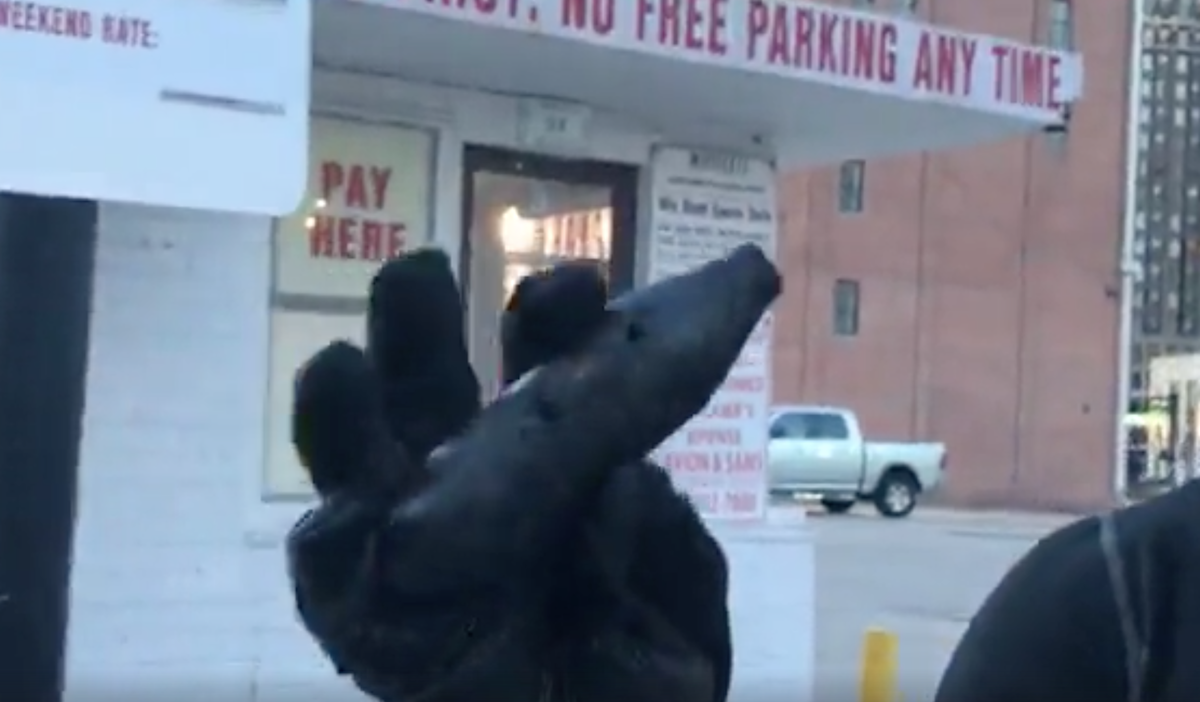Advisory: This story contains graphic images.
A young woman involved in protests against police brutality in Detroit last weekend suffered a skull-splitting brain injury when she says an officer fired what she believes was a rubber bullet at her head at close range.
Nadia Rohr appears to have suffered one of the more severe injuries among demonstrators who have come forward to say they've been hurt by police over the first five days of protests in downtown Detroit. Hundreds have gathered each night to protest the police killings of George Floyd and other black people across the country. Police have not intervened in nightly peaceful demonstrations or enforced an 8 p.m. curfew since Wednesday. Approximately 400 people have been arrested, though legal advocates insist many were unjustly detained and indescriminately hurt by police.

Demonstrators gather in downtown Detroit on Saturday, May 30. (Photo: Jack Thomas)
Rohr, 24, was injured in the early morning hours last Sunday, as police and demonstrators crossed paths near Grand River and Times Square. Medical records and photos reviewed by Deadline Detroit show she sustained a skull fracture and that her brain was bleeding. The injury briefly knocked her unconscious and required nine stitches.
Police departments across the country have shot rubber bullets to disperse crowds in the past two weeks of protests. But while they’re classified as “non-lethal,” or "less lethal," they can, in fact, be deadly and cause serious harm, particularly when shot at close range.
The Port Huron woman had attended the Saturday night demonstration with her girlfriend Baylee Huffman, 20, who previously lived in Detroit. The two say they have family and friends living in the city. Huffman’s mother was killed during a confrontation with police in Marine City in 2017.
The two said they demonstrated peacefully and provided supplies to participants.
“We were there to help bear a heavy burden and assistance, whether it be water, or bandages, or a hug,” Huffman said.
‘All I could see was brain matter, hair and flesh’

Rohr shows bruising as she heals on Friday night, Jun 5. (Photo: Huffman)
Last weekend’s peaceful protests descended into chaos after dark, as officers say they were pelted with rocks and other items, and peaceful protesters say they were indiscriminately hit with tear gas and rubber bullets.
Standing in front of the police line, Rohr says she locked eyes with an officer who aimed a bright orange “Nerf”-like gun at her. She turned and was struck in the back of the head.
“I remember a bright pink flash of light, losing consciousness,” said Rohr. “And then again coming to, I just looked down and my feet were being dragged.”
Fellow demonstrators began to move Rohr back from the line of fire, eventually helping her to her feet, the two said. One dumped water on her wound as Huffman assessed the injury.
“I looked at it and all I could see was brain matter, hair and flesh,” Huffman said.
They retreated near a dumpster as police continued to advance on the crowd.
Another demonstrator, who said he was a trained medic, examined her pupils and said she was concussed, a temporary state of unconsciousness or confusion.
Huffman worked with another protester to tie a makeshift bandage around Rohr's head, seen in a Twitter video. Several demonstrators nearby told police medical attention was needed, the pair said.
shot her ass in the head with a rubber bullet #DetroitProtest pic.twitter.com/n7gtF59jT8
— MKE (@PullupPete) May 31, 2020
An officer responded, “Send her over here. She shouldn't have been here anyway,” Rohr recalled.
After a long trek to their car, parked two miles away in Midtown, they drove to the emergency room at Henry Ford Macomb Hospital, where Rohr’s mother works.

Rohr (left) and Baylee Huffman pose for a selfie. (Photo: courtesy Huffman)
The paperwork said she’d suffered a head injury, open-skull fracture with a concussion and brain bleed.
“They said that because I had a hood on, that's the reason (the bullet) didn't lodge in my skull,” Rohr said.
Rohr says she’s considering legal action. She has not yet filed a formal complaint with the department, saying she feared for her safety.
The department told Deadline Detroit on Saturday it takes all allegations of abuse seriously. It said it would respond after consulting with the department's legal advisor.
Police say non-lethal, facts say otherwise
A blow from a rubber bullet at close range can be lethal. A 2017 analysis published in the British Medical Journal examined almost 2,000 rubber bullet incidents, and found 3 percent of people shot died and 15 percent were permanently injured.
The Detroit demonstrators have called for the police department to discontinue their use.
Craig is one of countless law enforcement officials around the country who’ve defended use of the weapons for crowd control. On Wednesday, he said officers had no choice but to use them after being hit with rocks and other objects.
“The problem is when you’re talking about large numbers of people and [an item is] thrown, you don’t know where it’s coming from,” he said in a Monday news conference. “And an officer can’t use deadly force without the possibility of not acquiring a target … A better option is to use those non-lethal munitions to disperse the crowd so the attacks can stop.”

A protester holds up a projectile he says police fired during last Sunday's demonstrations. (Photo: Detroit Free Press livestream)
As of Thursday, Craig said the department was reviewing at least three complaints filed against officers for their behavior during the demonstrations. One incident that’s under investigation has resulted in the reassignment of three officers who were seen shoving a man as he complied with their orders. A witness said he had just shown up at the protest.
Separately, the Detroit Board of Police Commissioners has received at least 10 formal misconduct complaints and a “record” 43 calls about officers during the protests on Wednesday alone, Michigan Radio reported.
Numerous demonstrators have described being roughed up by police as they were arrested in four of the first five nights of demonstrations. In a Free Press report chronicling several incidents, demonstrators said they were hurt even though they were away from the action and trying to get back to their cars.
Rohr said she saw other peaceful demonstrators get hurt.
“This is not … about me being victimized,” Rohr said. “ I don't feel that I was chosen over anybody else. There were other people being brutalized.
“I did see police dropping tear gas canisters next to very little children and rag dolling people, grabbing them by the backs of their shirts.”
“People who are running away, like turning to get away,” Huffman added.
Additionally, they say officers egged on the crowd, shouting “bring it on” as they banged their shields with batons in what has become a preamble for many confrontations.
“One of the things that is beginning to really piss me off is people coming to me that weren’t there trying to tell me, ‘Oh, that's not what happened. This isn't what happened.’ It's not their story to tell,” Rohr said.

Before stitches. (Photos: courtesy Nadia Rohr)
Medical staff told Rohr she can go back to work in three weeks, but full recovery could take up to a year and a half.
“I can't go swimming anymore. I can't skate anymore. I can't do any hard sports because if I hit my head again, it could be fatal,” said the 24-year-old.


 by
by








